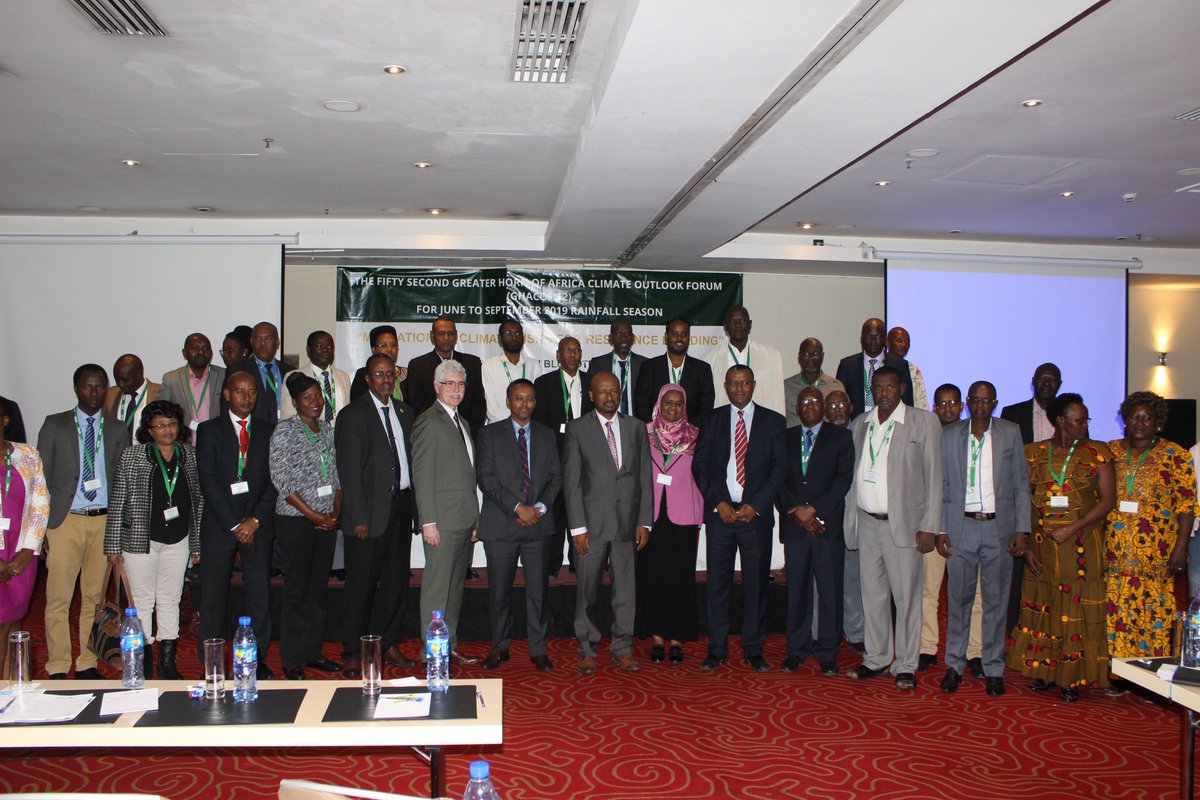27 to 28 May 2019. Addis Ababa. The IGAD Climate Prediction and Applications Centre (ICPAC), in collaboration with the National Meteorological Agency of Ethiopia and the World Meteorological Organization (WMO), organized the Fifty Second Greater Horn of Africa Climate Outlook (GHACOF 52),
The forum brought together climate scientists, researchers, users from key socio-economic sectors, governmental and non-governmental organizations, development partners, decision makers, and civil society stakeholders among others.
 Several user specific workshops were organized during the forum, including some covering agriculture and food security, livestock, water resources, energy, health, and disaster risk management. The forum was preceded by a capacity building training workshop for climate experts from the NMHSs of the ICPAC Member States at ICPAC, Nairobi, Kenya from 20 to 25 May 2019.
Several user specific workshops were organized during the forum, including some covering agriculture and food security, livestock, water resources, energy, health, and disaster risk management. The forum was preceded by a capacity building training workshop for climate experts from the NMHSs of the ICPAC Member States at ICPAC, Nairobi, Kenya from 20 to 25 May 2019.
The forum brought together climate scientists, researchers, users from key socio-economic sectors, governmental and non-governmental organizations, development partners, decision makers, and civil society stakeholders among others.
 Several user specific workshops were organized during the forum, including some covering agriculture and food security, livestock, water resources, energy, health, and disaster risk management. The forum was preceded by a capacity building training workshop for climate experts from the NMHSs of the ICPAC Member States at ICPAC, Nairobi, Kenya from 20 to 25 May 2019.
Several user specific workshops were organized during the forum, including some covering agriculture and food security, livestock, water resources, energy, health, and disaster risk management. The forum was preceded by a capacity building training workshop for climate experts from the NMHSs of the ICPAC Member States at ICPAC, Nairobi, Kenya from 20 to 25 May 2019.
Objectives
Review lessons/experiences from the use of the products provided during GHACOF 51.
Follow up on the implementation of proposed mitigation measures proposed in GHACOF 51.
Develop a consensus regional climate outlook for the June to September 2019 season.
Formulate mitigation strategies for key socio-economic sectors in the GHA region based on the seasonal forecast.
Provide a regional interaction platform for decision makers, climate scientists, research scientists as well as users of climate information.
Follow up on the implementation of proposed mitigation measures proposed in GHACOF 51.
Develop a consensus regional climate outlook for the June to September 2019 season.
Formulate mitigation strategies for key socio-economic sectors in the GHA region based on the seasonal forecast.
Provide a regional interaction platform for decision makers, climate scientists, research scientists as well as users of climate information.
Stakeholders and partners
The key stakeholders include the National Meteorological and Hydrological Services (NMHSs), namely: Institut Géographique du Burundi, Agence National de la Météorologie de Djibouti, Eritrea Meteorological Service, National Meteorological Services Agency of Ethiopia, Kenya Meteorological Department, Rwanda Meteorological Agency, Somalia Meteorological Service, South Sudan Meteorological Service, Sudan Meteorological Authority, Tanzania Meteorological Agency, Uganda National Meteorological Authority, and international partner organizations such as WMO, African Development Bank, WMO Global Producing Centres of long-range forecasts and World Bank, among others.
The key stakeholders include the National Meteorological and Hydrological Services (NMHSs), namely: Institut Géographique du Burundi, Agence National de la Météorologie de Djibouti, Eritrea Meteorological Service, National Meteorological Services Agency of Ethiopia, Kenya Meteorological Department, Rwanda Meteorological Agency, Somalia Meteorological Service, South Sudan Meteorological Service, Sudan Meteorological Authority, Tanzania Meteorological Agency, Uganda National Meteorological Authority, and international partner organizations such as WMO, African Development Bank, WMO Global Producing Centres of long-range forecasts and World Bank, among others.


No comments:
Post a Comment